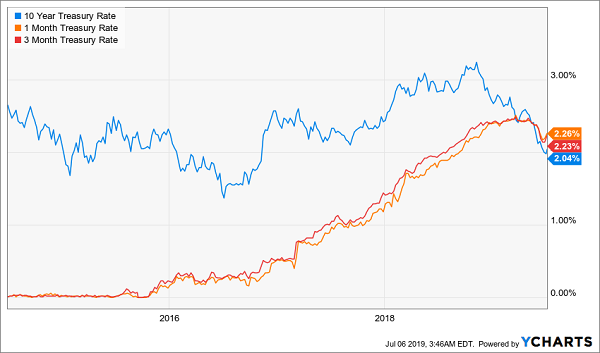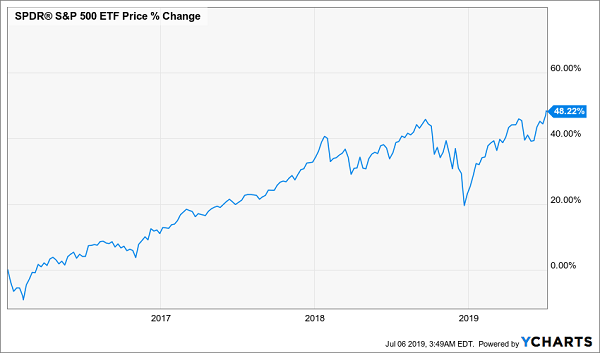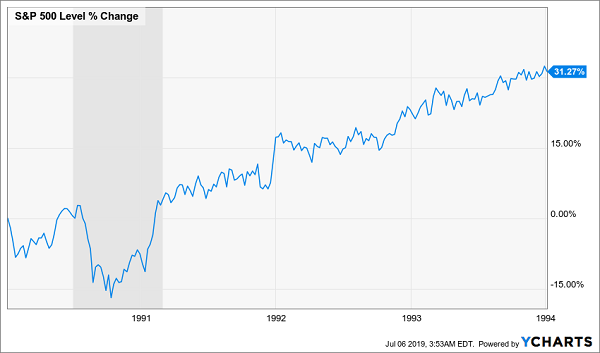Imagine if you could find a single signal that would warn you when a recession is on the horizon.
Well, one such indicator does exist—and it’s telling us that storm clouds are indeed building. That means it’s time for contrarians like us to get greedy for income (and gains)!
I’ll explain this seeming contradiction—and name a 6.7%-yielding fund that should be on your list—in a second. First, here’s more on this reliable “recession indicator.”
A Three-Decade History of Being Right
Campbell Harvey, an economist at Duke University, knows all about this recession signal: he was the first person to run across it, over 30 years ago.
In 1986, Harvey discovered that every time long-term Treasury yields were lower than short-term Treasury yields, a recession would occur within a year and a half.
Since then, the “inverted yield curve” has become one of the most widely recognized signs of a looming downturn.
So what’s it saying today?
Recession Signal Flashes Yellow

As you can see, the yields on the one-month—in orange—and three-month—in red—Treasuries have broken out above the yield on the 10-year Treasury—in blue.
A classic inverted yield curve.
So does this mean a recession is coming? Perhaps. While no one knows the future, this indicator does, in fact, say a recession is on the way. And if we follow its signal over history, that recession could start at the end of 2020 or the start of 2021.
So is it time to panic?
No way—as I mentioned, it’s time to buy (so long as you’re buying the right stocks and funds, of course). Here’s why.
I first started hearing from worried investors back in late 2015, when the yields on shorter-term Treasuries started their march toward those on longer-term notes, as you can see in the chart above.
But if you’d let recession fears push you into selling back then, you would have missed out on this:
Panic Selling Brings a Big Cost

Investors who took their nest egg out of the market when short-term yields started rising have missed out on their money growing by nearly half while they “wait out” the recession.
Remember the late-2018 bear market? Those who didn’t sell according to the recession indicator in late 2015 were still up 20% at the worst part of that correction—not bad!
And if you think it would be smart to sell now and avoid a potentially looming recession, you risk falling into the same trap these folks did. That’s because we could see 20% gains from now until the end of 2020. And remember that at its average, the stock market goes up about 7.5% per year.
That’s not all. Investors often forget that a recession typically means a stock-market panic that quickly reverses itself. While the crashes of 2001 and 2008 were different in that they took years to recover, these are rarities—more common is the quick snap-back, like we saw in 1990–91.
A Short Interruption to Growth

Investors who saw that recession coming and waited until it ended to get back in found themselves selling and buying at the same price. But that “safety” cost them two things: dividend payouts while they were out of the market and a chance to buy cheap, which investors who bought at the low points of the pullback took advantage of.
What to Buy: Stock-Focused Closed-End Funds
So with at least a year and a half (and maybe more) of gains to enjoy, what should we buy now?
For many folks, the automatic answer would be an index fund like the SPDR S&P 500 ETF (SPY). But savvy contrarians (and income-seekers) that we are, we’re going to pass on SPY and its skimpy 1.8% dividend and skip to stock-focused closed-end funds (CEFs).
A great example: the Nuveen S&P 500 Dynamic Overwrite Fund (SPXX), which holds many of the same household names as SPY—Microsoft (MSFT), Apple (AAPL), JPMorgan Chase (JPM) and Visa (V) among them.
So you can look forward to a portfolio that, like SPY, aims to track the S&P 500. But there’s one major difference: SPXX is an actively managed fund that sells call options against the stocks in its portfolio—and that helps it generate extra income.
That, in turn, helps drive a much bigger dividend: an outsized 6.7% yield, in fact. With a cash stream like that, you can choose when (or if) you want to reinvest your dividends. Meantime, your nest egg stays invested and benefits from the market’s long-term gains.
— Michael Foster
30% Gains. 8.7% Dividends. Get Both Here. [Sponsor]
If you want growth, income and “crash insurance” (and who doesn’t?), my 4 favorite CEFs now are perfect.
They pay an outsized 8.7% average dividend. And, unlike SPXX, they trade at huge discounts to net asset value (NAV, or the what their underlying portfolios are worth).
That gives us two critical wealth-building benefits:
- Price upside: If the markets hold steady or rise, these 4 stout income plays’ big discounts will slam shut, catapulting them to market-beating price gains (I’m calling for a 20%+ jump, on average, in the next 12 months.) With dividends, you’re looking at a potential 30%+ total return here!
- Downside “insurance”: If the market falls out of bed, these 4 funds’ big discounts set them up to simply trade flat. And we’ll still collect their massive 8.7% dividends.
These 4 “heads you win, tails you win” income plays (the highest payer of the bunch throws off an incredible 10.7% payout!) are waiting for now.
Source: Contrarian Outlook


